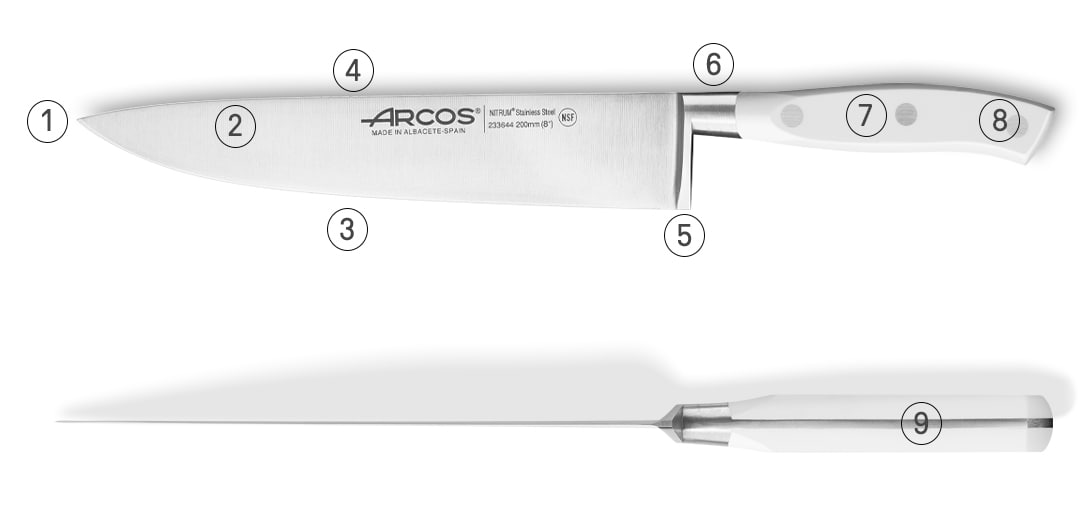Parts of a knife and their functions
In any kitchen, whether it is a domestic or professional space, the knife is one of the most indispensable and appreciated tools to carry out numerous daily tasks such as, for example, cooking and creating your favourite recipes.
From spreading to cutting with precision and boning. There are so many tasks that can be done with these tools and there is a different model for each use that we give them.
Although there is a wide range of knives available according to the use, the parts of a knife and the functions of each of these parts are usually the same in each of them.
Discover what the different parts of the knife are and what each of them is used for and find about one of your best allies in the kitchen when it comes to cooking your favourite dishes in much more detail.
Parts of a knife and their functions
In such a leading sector as that of the world of cutlery, knowing about the parts of a knife and the functions of each of them will help you appreciate the versatility of this tool that has such a major role in the kitchen even more.
Are you ready to put your apron on and start exploring all and each of the parts of a knife? We are going to tell you all about them!

| 1 |
TipWe are certain that the tip is the part of this super utensil that stands out the most. It is the pointed sharp end, by and large, which is located on the side opposite the handle. It goes without saying that it is the most delicate part of the knife and it is the sharpest and narrowest part of the blade. In short, the tip of the knife is the part that we use for cutting. |
| 2 |
BladeWhen we talk about the blade of a knife, we are referring to the main body of this utensil that cuts. In general, stainless steel is the most common material used to make knife blades. The blade is, definitely, one of the most versatile and most important parts of knives. Its most important functions include the following:
If a knife has scallops or dimples cut into the edge of the blade it has what is known as a granton edge. The grooves or divots that are created help stop food sticking to the blade. |
| 3 |
EdgeThe sharpest part of the blade of a knife is called the edge. This area lets the cook make clean cuts on any type of food. According to the use and the type of knife, the edge can be classified into different groups:
|
| 4 |
SpineThe part of the knife blade that is opposite the knife edge is called the spine. This part, together with the blade, is one of the most functional parts of these utensils. As well as being an essential part that affects the balance of the knife, the spine creates a feeling of stability and control when the knife is held by the user. It is the thickest and widest area of the blade and it gives this tool its strength. One of the more premium Arcos ranges of knives has a rounded spine. It is designed to prevent any injuries to hands when the knife is being used. |
| 4 |
SpineThe part of the knife blade that is opposite the knife edge is called the spine. This part, together with the blade, is one of the most functional parts of these utensils. As well as being an essential part that affects the balance of the knife, the spine creates a feeling of stability and control when the knife is held by the user. It is the thickest and widest area of the blade and it gives this tool its strength. One of the more premium Arcos ranges of knives has a rounded spine. It is designed to prevent any injuries to hands when the knife is being used. |
| 5 |
GuardHunting knives also have special features; these include the quillon of a knife. Do you know exactly what we are talking about? The quillon or the guard is the area that helps to protect the hand from getting in the way of the knife edge when cutting. It is the part that is designed to provide protection and control for the user when cutting. It is in charge of reducing, to the maximum, the number of injuries that might be caused when using this utensil. Although the shape and the design depend on the type of knife, the guard always makes the knife easier to use when cutting. |
| 6 |
BolsterThe bolster is the part that joins the handle to the blade. This is an essential part of the knife. It is a thick band of metal that joins the handle to the blade without any type of welding and it also prevents the handle from cracking and it makes it more durable, and it is an important part of the knife that stops the user’s hands from slipping. |
| 7 |
ScalesThe scales of a knife are the two parts that create the handle. They also guarantee a safe and ergonomic grip. These areas of the knife help make the cuts precise and, furthermore, they enhance the aesthetics of the knife. |
| 8 |
RivetsThe main function of the rivets of a knife is to join the scales to the tang completely. The rivets join these parts of the knife together permanently by creating a completely solid connection between them.
|
| 9 |
TangThe metal part of the knife that runs right through the handle inside is called the tang. This tang is indispensable and essential in the structure of a knife and, it also helps distribute the weight of the whole utensil.
|